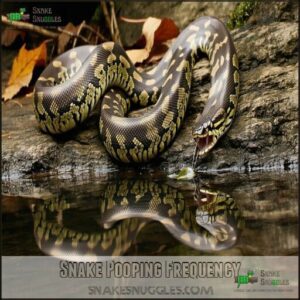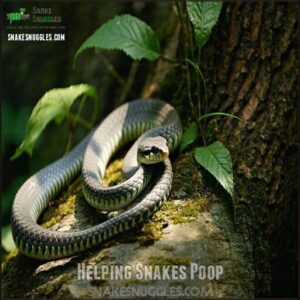This site is supported by our readers. We may earn a commission, at no cost to you, if you purchase through links.

As you learn about snake digestion, you’ll find it’s surprisingly efficient, breaking down whole prey into droppings containing brown/black feces, white urates, and prey remnants.
The process takes days to weeks, depending on meal size.
Now that you know the basics of how do snakes poop, you’re ready to uncover more fascinating facts about their unique digestive system and what their poop can reveal about their health.
Table Of Contents
- Key Takeaways
- Snake Pooping Basics
- How Do Snakes Poop
- Snake Digestive System
- Snake Poop Appearance
- Snake Pooping Frequency
- Snake Constipation Issues
- Helping Snakes Poop
- Snake Poop Health Indicators
- Snake Waste Elimination
- Frequently Asked Questions (FAQs)
- How do snakes poop & Pee?
- How can one poop while having an anal fissure?
- Do snakes poop?
- Why does my snake poop a lot?
- Where does a snake produce its poop?
- How long does it take a snake to poop?
- How does the snake poop?
- How does a snake excrete its waste?
- How do you know when a snake is about to poop?
- What is the yellow stuff in snake poop?
- Conclusion
Key Takeaways
- You’ll find that snakes poop through a multi-purpose opening called the cloaca, which handles waste elimination, reproduction, and urination all in one spot, making their digestive system surprisingly efficient.
- You’ll notice that a snake’s digestive system breaks down whole prey into waste, producing droppings that typically contain brown or black feces, white urates, and sometimes visible prey remnants like fur or feathers.
- You can monitor your snake’s health by observing their bowel movements and stool characteristics, tracking poop schedules and defecation patterns to identify potential issues early on and take action to keep your pet thriving.
- You’ll learn that understanding how snakes poop helps you provide better care, including feeding smaller prey, handling them gently, soaking their food, and maintaining proper hygiene practices to promote healthy snake poop and cloaca function.
Snake Pooping Basics
You’ll find that snakes poop through a specialized opening called the cloaca, which handles waste elimination, reproduction, and urination all in one spot.
Your snake’s digestive system processes whole prey items completely, producing droppings that typically contain brown or black feces, white urates, and sometimes visible prey remnants like fur or feathers.
Snake Anatomy and Digestion
Inside your snake’s streamlined body lies a fascinating digestive system that’s perfectly designed for consuming whole prey.
Your serpentine friend’s jaw structure allows it to unhinge and stretch remarkably, while powerful digestive enzymes break down everything – even bones.
The cloaca serves as a multi-purpose opening for waste elimination and reproduction, and the swallowing mechanism works without chewing.
- The cloaca serves as a multi-purpose opening for waste elimination and reproduction
- Intestinal motility pushes food through the digestive tract
- Snake excretion occurs through the vent
- The swallowing mechanism works without chewing
- Snake anatomy includes a specialized esophagus separate from the windpipe.
Snake anatomy is also notable for its ability to consume prey whole, thanks to its powerful digestive enzymes and the unique structure of its jaw and digestive system, making it a highly efficient hunter.
The combination of these features allows snakes to thrive in various environments, and their digestive system is a key factor in their success.
Normal Snake Poop Characteristics
Looking closely at healthy snake poop reveals a fascinating mix of components.
You’ll notice brown or black feces alongside chalky white urates and occasional mucus.
The consistency varies between species, with some producing firmer waste than others.
Prey remnants like fur, feathers, or bones often appear in reptile poop, while fecal color can range from dark brown to yellowish, depending on recent meals, and this variation can be linked to the type of prey and the snake’s digestive process, which includes the presence of urates.
How Do Snakes Poop
The fascinating process of snake defecation involves a complex series of muscle contractions that move waste through their digestive system.
You’ll find that snakes eliminate waste through their cloacal opening, which serves multiple functions in their anatomy.
The snake’s body efficiently processes prey, pushing undigested matter along until it’s ready for elimination.
Here’s what happens during a snake’s waste elimination process:
- Powerful muscular waves compress and move digested food through the reptile digestive system
- The digestive process breaks down prey completely, leaving only indigestible parts like fur or feathers
- Special muscles around the cloaca control the timing of waste release
- Snake poop emerges as a combination of fecal matter and white urates
- The entire process can take anywhere from a few days to several weeks, depending on meal size
This efficient system helps snakes maintain their streamlined body shape while maximizing nutrient absorption from their prey, which is crucial for their survival, and it also involves the reptile digestive system in a unique way that allows for efficient waste elimination and overall health.
Snake Digestive System
You’ll find that a snake’s digestive system works like a highly efficient processing plant, where food travels from mouth to cloaca through specialized organs that break down whole prey.
Your snake’s digestive tract includes an esophagus, stomach, and intestines that work together to extract nutrients before waste exits through the multipurpose cloaca.
Structure of The Snake Digestive Tract
A snake’s digestive tract follows a remarkably streamlined design.
You’ll find the mouth leads to an elastic esophagus, connecting to a specialized stomach chamber.
The small and large intestines work together, efficiently processing nutrients before waste moves to the cloaca.
Unlike mammals, snakes have evolved a single-opening system in their cloaca that handles waste elimination, reproduction, and egg-laying functions.
Function of The Stomach in Digestion
The stomach’s powerful gastric juices break down your snake’s prey through a fascinating chemical dance.
When food enters, stomach acid and enzymes launch into action, dissolving tissues and bones with remarkable efficiency.
- Stomach acid in snakes is 100 times stronger than human stomach acid
- The digestion process can take 3-7 days depending on prey size
- Temperature affects how quickly gastric juices work
- Snake stomachs can expand up to 6 times their normal size
- Enzyme action continues even while your snake sleeps
Role of The Intestines in Nutrient Absorption
Understanding intestinal function in snakes reveals a remarkable digestive efficiency.
Their intestines act like a sophisticated nutrient extraction system, wringing out essential proteins, fats, and minerals from prey.
You’ll find the snake digestion process highly optimized – their gut health depends on specialized cells that maximize absorption rates.
The digestive tract’s unique adaptations guarantee thorough nutrient uptake, making their reptile digestion incredibly effective.
Snake Poop Appearance
You’ll notice that healthy snake droppings contain three distinct components: brown or black feces, white chalky urates, and sometimes clear mucus.
When you examine your snake’s waste, you can spot undigested prey remains like fur, feathers, or small bones mixed within the feces, which is completely normal for these remarkable reptiles.
Color and Consistency of Snake Feces
When inspecting your snake’s feces, you’ll notice the texture ranges from firm to slightly mushy, while healthy snake poop colors typically appear brown or black.
The stool colors can vary based on recently consumed prey, with darker shades indicating proper digestion.
Waste analysis reveals that fecal odor and consistency offer valuable insights into your reptile’s health – firm, well-formed droppings suggest effective digestive function.
Understanding the snake cloaca system is essential for recognizing normal and abnormal waste elimination patterns in snakes, and this knowledge can help you identify potential health issues related to digestive function.
Presence of Urates and Mucus
When examining snake droppings, you’ll notice two distinct components: urates and mucus.
The urates appear as chalky white deposits, composed primarily of uric acid – your snake’s version of urine.
The mucus, a slippery substance coating the feces, serves as a natural lubricant for smooth excretion.
Together, these elements combine with fecal matter, creating the characteristic snake waste that helps you monitor your pet’s health.
Snake Pooping Frequency
You’ll notice your snake doesn’t poop as often as most pets, since these remarkable reptiles can go weeks between bowel movements depending on their size, diet, and species.
Ball pythons typically defecate every 7-10 days after a meal, while larger constrictors like Burmese pythons might only eliminate waste every 2-3 weeks, which is a notable difference in their defecate patterns.
Factors Affecting Pooping Frequency
Several factors influence how often snakes do their business, and it’s a fascinating insight into their digestive health.
Here are the key players:
- Diet Type: Snakes need time to digest large meals, so the size of their prey impacts poop frequency.
- Age and Size: Younger snakes tend to poop more often due to their faster metabolism.
- Metabolic Rate: Active snakes have higher metabolic rates, affecting how often they poop.
- Environment: As ectotherms, a snake’s body temperature and metabolism are influenced by their surroundings, which can speed up or slow down digestion.
Understanding the snake digestive system is vital for determining the frequency of snake pooping.
Variations Across Snake Species
You’ll find variations in snake poop frequency across species, with larger snakes pooping less often.
Species comparison reveals snake diversity affects digestion, from venom variance to habitat impact and geographic differences, influencing snake poop and cloaca function in reptile species, including unique snake digestion patterns.
Snakes’ digestive systems feature a multifunctional cloaca for waste elimination, which is a key aspect of their digestive systems and overall biological function.
Snake Constipation Issues
You’ll notice that your snake is having trouble pooping if it’s straining or taking a long time to pass stool.
If you suspect your snake has constipation, it’s vital to identify the causes and signs, such as lack of appetite or abnormal stool, to provide proper care, including recognizing abnormal stool.
Causes of Constipation in Snakes
You may cause snake constipation through dehydration, parasites, obstruction, stress, or improper husbandry, leading to snake impaction and poor digestive health, affecting your snake’s bowel movement and overall well-being.
So make sure to provide proper care to prevent constipation in snakes.
Proper snake care involves understanding constipation relief methods to address potential issues promptly, which is crucial for constipation relief and maintaining your snake’s digestive health.
Signs and Symptoms of Constipation
You’ll notice reduced frequency of bowel movements, straining to defecate, a bloated abdomen, loss of appetite, and lethargy in snakes with constipation, indicating potential impaction and digestive health issues, requiring prompt attention to prevent severe snake constipation complications.
Persistent constipation can indicate serious underlying issues, so understanding effective snake constipation treatment is essential for reptile owners to address potential digestive health issues.
Helping Snakes Poop
You’re taking steps to help your snake poop by trying methods like feeding smaller prey or handling it gently.
By following these tips, you can encourage your snake to poop regularly and maintain its overall health.
Feed Smaller Prey
Feeding smaller prey helps your snake’s digestion speed, reducing waste volume and easing bowel movements.
Smaller meals promote efficient nutrient absorption in the snake digestive system, resulting in healthier snake poop and smoother excretion, aligning with reptile digestive processes.
For effective digestion, consider live prey feeding benefits, which is a key factor in maintaining your snake’s overall health, and can lead to healthier snake poop, and support efficient nutrient absorption.
Handle The Snake
When handling your snake, make sure safe handling with proper support and gentle restraint to reduce stress.
This promotes healthy snake poop and cloaca function, which is key to understanding how snakes poop.
Maintaining overall snake health through good hygiene practices, especially around the vent area, is crucial.
Soak The Food
You’re helping your snake poop by soaking food, aiding digestion and water absorption.
A snake food soaker product can assist with this process.
Softening food, aiding prey hydration, reducing bacterial growth, helping digestion aid, all benefit the snake’s digestive system and cloaca, making it easier to answer, how do snakes poop, regarding their snake poop.
This process involves understanding the importance of water absorption in the snake’s digestive health.
Soak The Snake
You often soak your snake to aid digestion, ensuring proper snake hydration.
Soaking techniques involve water temperature and soak duration, maintaining suitable humidity levels, which helps the snake’s digestive system and cloaca function, facilitating snake excretion and preventing issues with snake poop, a key aspect of the snake’s overall health.
Effective snake care also involves using proper snake soaking kits to create a suitable environment for digestion.
Snake Poop Health Indicators
You’re checking your snake’s poop to make sure it’s healthy, and that’s a great idea.
By monitoring your snake’s bowel movements and stool consistency, you can identify potential health issues early on and take action to keep your pet thriving, which is a key part of ensuring your snake stays healthy.
Monitoring Frequency of Bowel Movements
You monitor your snake’s bowel movement frequency, tracking poop schedules and defecation patterns.
- Observe waste cycles
- Note elimination rates
- Research snake poop frequency
- Understand how snakes excrete
- Check snake digestive health, focusing on complete concepts and separate lines to ensure clarity, and also considering snake poop frequency.
Changes in Stool Color or Consistency
You’ll notice color changes or consistency variations in snake poop, indicating health issues.
Blood in stool or undigested food can signal problems, while parasite presence affects snake poop color and consistency, distinguishing healthy from unhealthy snake poop, which can be indicated by parasite presence.
Snake Waste Elimination
You’re now exploring how snakes eliminate waste.
Building on the importance of monitoring their poop health, let’s discuss the waste removal process.
Snakes use their cloaca, a multi-purpose opening, for excretion. The cloacal function involves removing waste and urates, which are chalky, white components of snake poop.
This unique excretion mechanism is part of their digestive role, where the cloaca plays a key part in eliminating waste, making snake waste removal a fascinating process, showcasing how snakes excrete and the composition of urates in their poop, highlighting the cloaca’s critical function in reptile waste management.
Understanding snake constipation solutions is essential for maintaining healthy digestion in snakes.
Frequently Asked Questions (FAQs)
How do snakes poop & Pee?
You’ll be surprised, snakes poop and pee through their cloaca, a multi-purpose opening, using muscular contractions to move waste out, a unique process, really.
How can one poop while having an anal fissure?
You’ll need to take it easy, as straining can worsen the fissure, so try to relax and let nature take its course.
Or consult a doctor for personalized advice and treatment.
Do snakes poop?
You’ll be amazed – snakes definitely poop, producing brown or black feces, urates, and sometimes mucus or urine through their multi-purpose cloaca, a unique opening near their tail end.
Why does my snake poop a lot?
You notice your snake pooping a lot, which could indicate a healthy appetite or digestive issue.
So monitor its diet and stool quality to confirm it’s not a sign of illness.
Where does a snake produce its poop?
Cut to the chase, you’ll find a snake produces poop in its intestines, which then gets eliminated through the cloaca, a multi-purpose opening near the tail’s end, pretty cool, right?
How long does it take a snake to poop?
You’ll find that snakes take varying times to poop, depending on factors like species, size, and diet, with digestion lasting longer than in humans due to stomach acid breakdown.
How does the snake poop?
You see, snakes poop through their cloaca, a multi-purpose opening, using muscular contractions to move digested food out, often leaving behind brown or black feces with urates and prey remnants.
How does a snake excrete its waste?
You excrete waste through the cloaca, a multi-purpose opening near the tail.
Where muscular contractions move digested food out, along with urates, and sometimes mucus or urine, in a single process.
How do you know when a snake is about to poop?
You’ll notice a snake is about to poop when it exhibits restlessness, raises its tail, or displays a distinctive poop dance, signaling an impending bowel movement.
What is the yellow stuff in snake poop?
You’ll identify urates as the yellow stuff in snake poop, a normal, chalky component of their droppings, varying by species, and sometimes accompanied by feces, mucus, or urine.
Conclusion
Now you know the truth about how do snakes poop, it’s surprisingly efficient.
You’ve learned their digestive system breaks down prey into waste.
Understanding how do snakes poop helps you monitor their health, so observe their bowel movements and stool characteristics to confirm they’re thriving, and you’ll be well on your way to becoming a snake expert, mastering the art of caring for these fascinating creatures.
- https://blogs.ucl.ac.uk/researchers-in-museums/2016/11/09/question-of-the-week-how-do-snakes-poop/
- http://www.wildlife-removal.com/snakepoop.html
- https://jeb.biologists.org/content/206/10/1600
- https://azeah.com/reptiles-amphibians/recognizing-abnormal-feces-reptiles
- https://pethelpful.com/reptiles-amphibians/Common-Health-Problems-Snakes















